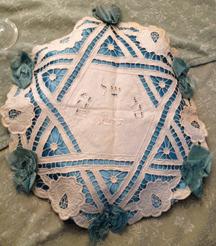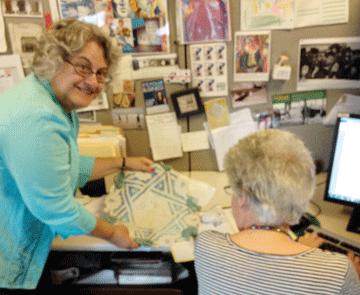
Family means everything to Ellen Portnoy. She knows her family history very well and has portraits of family members from past generations proudly displayed in her home. But she felt one family heirloom was better shared with the world than displayed once a year during Passover at her Overland Park home. So it now resides in a New York museum.
Last August, Portnoy donated a matzah cover hand-made by her great-grandmother to The Museum of Jewish Heritage, a living memorial to the Holocaust in New York City. {mprestriction ids="1,3"}The museum’s mission is to educate people of all ages and backgrounds about the broad tapestry of Jewish life in the 20th and 21st centuries — before, during and after the Holocaust.
For 25 years, Portnoy used that matzah cover when she hosted a second seder. She admits she’s a little weepy when she thinks about not having it gracing her table this year.
“I do feel a little bad about it not being here. I think if my mother was still alive I wouldn’t have done it, because I think it would have more upsetting if she was still here,” Portnoy said.
Portnoy’s decision to donate the matzah cover goes back a couple of years following the death of her parents. Her mother, Frances Amsterdam Rosenberg, passed away in late 2010. Her father, Donald Rosenberg, passed away a few months later in 2011. While cleaning out their parents’ apartment, she and her siblings found two items of interest —a 1930s program for a benefit to help the Jews of Europe and a cookbook in English and Yiddish to help immigrants learn to cook American meals.
Those were the first items the Rosenberg family donated to the Museum of Jewish Heritage.
“This way they will survive, and others who might be doing research or want to know about life for immigrant women would have these items. They will be protected,” Portnoy said.
Portnoy was in sole possession of the matzah cover, made in 1901 by her great-grandmother Chava Amsterdam. Chava lived in the city of Mielic in Galecia, a region in Eastern Europe better known to us as Poland. Portnoy’s mother gave it to her for several reasons.
“First because I was named for my great-grandmother. Second, because I also do embroidery. Third because my parents would come and spend the second night of Pesach with me. Fourth because my daughter is the oldest grandchild. I think they thought I would pass it on to her,” she wrote in her blog.
It is believed Chava made the matzah cover for her son Nissan, who was born in 1900 on the first of Nissan. Later, when he was living America, he became known as Nathan. The matzah cover was probably completed in 1901, as that date is stitched on the matzah cover, along with the words Seder shel Pesach (Seder of Passover) in Hebrew.
The matzah cover features an intricately embroidered Star of David. Portnoy believes her great-grandmother used a button-hole embroidery stitch and then cut it out so that the teal/blue fabric beneath shows through. Flowers of the same teal/blue silk fabric were also sewn on the cover.
“I would almost call it candle-wicking embroidery because the yarn is the same color as the fabric. She used the blue to make it more colorful,” explained Portnoy, who also noted that she believes the silk fabric color has changed over the years and was probably a deeper blue that was used in many Jewish ritual objects.
Nathan — Portnoy’s maternal grandfather — was smuggled out of Poland to escape the military, which Portnoy said was “not a good thing for a nice Jewish boy.” He was supposed to go to Israel, but instead came to America, arriving in 1920

The matzah cover came to the USA in 1932.
“My grandmother took my mother, then age 2, and her brother, age 5, to Europe for six months. They stayed with my great-grandparents. And my great-grandmother gave the matzah cover and some other family items to my grandmother to bring back to the United States with her family.”
When Portnoy put the matzah cover on the table every year, she said she always felt connected to her family and she was always especially careful with it. She would put it on the table for all the guests to see, but when the seder began she switched it out with another one because she didn’t want anything to happen to it.
“That’s why it stayed in such good shape, it never got spilled on.”
“It was so special because my great-grandmother died in the Holocaust and here was something that she made that survived and that we could have that memory of her,” she said. “It was really an important part of family tradition.”
“You don’t see that many Jewish items that survived the war in Europe,” she continued. “My sister has my great-grandmother’s silver Shabbos candlesticks.”
When Portnoy first approached the museum about the matzah cover, she sent them photos of it.
“I contacted her around Purim last year. Then I told her I wanted to use it one more Passover before I gave it away.”
“They hadn’t seen one that good and it was also big and so well made,” Portnoy said. “They said it reflects how vibrant the life was in Poland before the Holocaust.”
Indeed the museum is thrilled to have the item, according to Esther Brumberg of its artifacts donation department.
“We have found over the years that hand-made things done by women are very hard to come by as they are passed down by mother to daughter until they are unusable,” said Brumberg. “We are delighted that Ellen and her family decided to donate it. It’s perfect for us because we are more about families and family stories that the art itself.”
Now the 114-year-old precious piece of Amsterdam-Rosenberg-Portnoy family history — donated in memory of Nathan (Nissan) and Thelma (Tova) Amsterdam — will receive the white-glove treatment, never again to be touched by bare human hands. While it is not currently on display, Portnoy and her siblings may see it whenever they wish.
Portnoy firmly believes she made the right decision to put the matzah cover in the museum.
“I hope by sharing it with so many people, it will have continued life, and perhaps help people understand how extraordinary Jewish life was in Europe before the Shoah.”
“Also, we always say in Judaism when someone dies may their name be a blessing,” she continued. “I think donating things like this is a way we keep her name alive. Because when the matzah cover is on display there will be a photo of her along with her name and a little history about it, so my great-grandmother’s name will never die. Even though she was murdered in the Holocaust, a piece of her is there (in the museum) and she will never die.”{/mprestriction}



